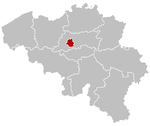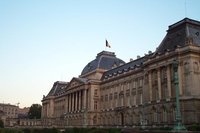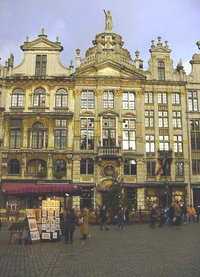Brussels
|
|
Belgium_brussels_iris.png
Flag_-_city_of_brussels_(municipality).png
Brussels (Dutch: Brussel, French: Bruxelles, German: Brüssel) is the capital of Belgium and is considered by many to be the headquarters of the European Union, as two of its three main institutions have their headquarters in the city.
Brussels is first of all a city located in the centre of Belgium and its capital, but it sometimes also refers to the largest municipality of the Brussels-Capital Region. This municipality inside Brussels is correctly named The City of Brussels (French: Bruxelles-Ville or Ville de Bruxelles, Dutch: de Stad Brussel), which is one of 19 municipalities that make up the Brussels-Capital Region (see also: Municipalities of the Brussels-Capital Region). The municipality has a population of about 140,000 while the Brussels-Capital Region has almost a million inhabitants. Brussels is located at 50°50' North, 4°20' East (50.8333, 4.3333). [1] (http://earth-info.nga.mil/gns/html/cntry_files.html)
The Brussels-Capital Region is a region of Belgium in its own right, alongside the Flemish Region and Wallonia. Geographically, it is an enclave of the Flemish Region. Regions are one component of Belgium's complex institutions, the three communities being "the" other component: the Brussels inhabitants must deal with either the Flemish Community or the French (speaking) community for matters such as culture and education.
Brussels is also the capital of the Flanders and of French Community of Belgium (Communauté française Wallonie-Bruxelles in French) ; all Flemish capital institutions are established here: Flemish Parliament, Flemish government and its administration.
Two of the three main institutions of the European Union - the European Commission and the Council of the European Union - have their headquarters in Brussels: the Commission in the Berlaymont building and the Council in the Justus Lipsius building facing it. The third main institution of the European Union, the European Parliament, also has a parliamentary chamber in Brussels in which its committee meet and some of its plenary sessions are held (the other plenary sessions are held in Strasbourg, and its administrative headquarters are in Luxembourg).
Brussels is also the political seat of NATO, the North Atlantic Treaty Organisation, and the Western European Union (WEU).
The "language frontier" divides Belgium into a northern, Dutch-speaking, region and a southern, French-speaking, region. The Brussels-Capital Region is officially bilingual, while the majority of its residents speaks French (see the linguistic history of Brussels in this article's history section).
The highest building in Brussels is the South Tower (150 m); the most famous probably the Atomium, which is a remnant from the Expo '58.
| Contents |
Etymology
The name Brussels comes from the old Dutch Bruocsella, Brucsella or Broekzele, which means "marsh (bruoc, bruc or broek) home (sella or zele)" or "home in the marsh". "Broekzele" was spelt "Bruxelles" in French. In Belgian French pronunciation as well as in Dutch, the "k" eventually disappeared and "z" became "s", as reflected in the current Dutch spelling. The names of all other municipalities in the Brussels-Capital Region are also of Dutch origin, except for Evere, which is of Celtic origin.
History
Palaisd'EgmontBrussels.jpg
In 977, the German emperor Otto II gave Lower Lorraine to Charles, son of King Louis IV of France. Mention was already made of Brussels at the time. However, the founding of Brussels is usually known to happen when a small castle was built by Charles around 979 on an island (called Saint-Gery island) encompassed by the Senne river. At the end of the tenth century, with the death of Charles, Lower Lorraine was taken over by Lambert I of Leuven. Under Lambert II of Leuven, a new castrum and the first city walls were built. The small town became in the 12th century an important stop on the commercial road from Bruges to Cologne; the Counts of Leuven changed their name to Dukes of Brabant at about this time also. From 1357 to 1379, a new city enclosure was constructed as the former one was already proving to be too small: it is now known as the inner ring or pentagon. In the 15th century, by means of the wedding of heiress Margaret III of Flanders with Philip the Bold, Duke of Burgundy, a new Duke of Brabant emerged from the House of Valois (namely Antoine, their son), with another line of descent from the Habsburgs (Maximilian of Austria, later Maximilian I, Holy Roman Emperor, was Philip's father).
In 1695 Brussels was attacked by King Louis XIV of France: the battle was responsible for the flattening of the city's heart, the Grand Place, and the razing of what was left: more than 4000 houses, including the buildings of the Grand Place, were all destroyed, except for the famous city hall, the Hôtel de Ville, which miraculously survived).
In 1830, the Belgian revolution took place in Brussels after a representation of La Muette de Portici at La Monnaie theatre. On July 21, 1831, Leopold I, the first King of Belgium, ascended the throne, undertaking the destruction of the city walls and the construction of many buildings. Under Leopold II of Belgium, the city underwent many more changes: the Senne was arched (as it brought diseases), becoming sewers, the North-South Junction was undertaken, the Tervueren avenue was traced, etc.
From May 10, 1940, Brussels was bombed by the German army. A lot of damage was done with bombs mainly in 1943-1944. The Heysel Stadium disaster took place in Brussels on May 29, 1985. The Brussels Capital Region was founded on June 18, 1989.
Linguistic history
The Brussels Capital Region is currently home for both French- and Dutch-speakers, the former accounting for about 80% of its population. Dutch, or more precisely its "linguistic predecessors", was however the language of the city from its foundation. In those first 6 centuries, French was only used in the relations with the then "Romance-speaking" (linguistic predecessors of French) areas around Nivelles. During the Austrian period, 'Dutch' remained the popular language in Brussels, and French was for several centuries only spoken by the haute-bourgeoisie and the nobility. It started becoming only a somewhat popular language under the French regime, and especially after 1830, by the immigration of many French (revolutionaries and others) and many Walloons, attracted by the new Belgian authorities. As in 1830, only the haute-bourgeoisie and the nobility (1% of the population) had voting rights, these groups wanted to fashion the new state along their personal preferences. As a result, they had to attract many French-speaking Walloons to staff the public services.
The area, which is geographically situated in the south of Flanders, was still mostly Dutch-speaking until the middle of the 20th century. During the 19th and 20th century, more and more French-speaking civil servants coming from Wallonia settled in Brussels and persistent social, administrative, cultural and political pressure made many Flemings switch their vernacular to French.The Brussels-Capital region nowadays is officially French-Dutch bilingual and some municipalities in Flanders around Brussels have special linguistic facilities for French-speaking minorities in Flanders.
Brusselsskyline.jpg
On 4 September 1998 the Council of Europe published a resolution entitled "Situation of the French-speaking population living in the Brussels periphery" [2] (http://assembly.coe.int/documents/workingdocs/doc98/edoc8182.htm) which focussed on a linguistic conflict affecting six communes in Flanders, and made recommendations to both the Flemish government and the French-speaking inhabitants.
The International Labour Organization, a UN agency, reported ([3] (http://www.ilo.org/public/english/protection/migrant/papers/imp23/ch10.htm)) the results of an experiment involving two testers applying for jobs in Belgium, where the Moroccan job applicant was discriminated against in favour of the Belgian.
On the one hand, many Flemings complain about strong pressure from French-speakers against the bilingual status within the Brussels-Capital region. The Belgian judiciary has never engaged in any official investigation; all such complaints are still pending. In the early 90's, an official declaration from the regional government explicitly acknowledged that social housing was de facto reserved entirely for those applying in French. As late as 2003, Rudy Demotte, the federal Minister of Public Health and a French-speaking socialist, has publicly acknowledged that urgent medical services discriminated against Dutch speakers, in the sense that it was often difficult for Dutch speakers to use their own language [4] (http://assembly.coe.int/Documents/WorkingDocs/Doc03/FDOC10009.htm).
On the other hand, there are reports and claims of discrimination against French-speakers in the outskirts of Brussels regarding access to health care, using their own language, and social housing [5] (http://assembly.coe.int/Documents/WorkingDocs/Doc04/EDOC10115.htm) [6] (http://assembly.coe.int/Documents/WorkingDocs/Doc02/EDOC9536.htm) [7] (http://assembly.coe.int/Documents/AdoptedText/TA98/eres1172.htm). However, it should be noted that the outskirts in question are part of the Flemish Community.
Though no official census has been made for a long time, the French-speaking population in Brussels accounts for about 80% of the population. In recent years, the Flemish region is taking measures to decrease this percentage (by offering STIB subscription to Flemish students in Brussels and by giving the proceeds to Flemish people settling in the city).
Universities
Brussels has several universities, two of them being the Université Libre de Bruxelles (ULB) and the Vrije Universiteit Brussel (VUB). A satellite campus of the Université catholique de Louvain (UCL) is also located in Brussels: it is called "Louvain-en-Woluwe" or "UCL-Brussels", and hosts the faculty of Medicine of the university. There is also the Catholic University of Brussels a Dutch-language university.
Transport
Brussels is served by Brussels National Airport, located in the municipality of Zaventem, and by Brussels South Airport, located near Charleroi, some 80km from Brussels. Brussels' major train stations link the city to the United Kingdom by Eurostar, and to major European cities by high speed rail links (such as the Thalys).
Metro_bruxelles_station_debrouckere.jpg
The Brussels metro dates back to 1976 (but underground lines known as premetro have been serviced by tramways since 1968). A comprehensive bus and tram network also covers the city. Brussels also has its own port on the Willebroek canal located in the North-East.
There are four companies managing public transport inside Brussels :
- STIB/MIVB (metro, bus, tram)
- SNCB/NMBS (train)
- De Lijn (bus)
- TEC (bus)
The first two work together as a STIB/MIVB ticket holder can use the train freely inside the city. The last two are especially used by respectively Walloons and Flemish as it is expensive (in regard with the number of lines) for people living in Brussels (assuming they mostly use STIB/MIVB network). Those companies goal (in Brussels) is to permit people living in the suburbs to join the capital city. This purpose is shared by SNCB/NMBS as they will soon install a RER network around Brussels.
Railway stations
The major stations in Brussels are on the North-South Junction:
- Brussels North (Dutch: Brussel-Noord, French: Gare du Nord)
- Brussels Central (Dutch: Brussel-Centraal, French: Gare Centrale)
- Brussels South (Dutch: Brussel-Zuid, French: Gare du Midi or Bruxelles-Midi) (the Eurostar, Thalys, TGV and ICE international terminal)
Two more stations serve the EU district in Brussels. Trains towards Namur and Luxembourg call here :
- Brussels Luxembourg
- Brussels Schuman
The last two stations located in the municipality of Brussels (they also are on the North-South Junction) are :
- Brussels Congress (French: Bruxelles-Congrès, Dutch:Brussel-Congres)
- Brussels Chapel (French: Bruxelles-Chapelle, Dutch: Brussel-Kapellekerk)
Other railway stations in other Brussels municipalities include :
- Schaarbeek
- Etterbeek
- Uccle Stalle (Dutch: Ukkel Stalle)
- Uccle Calevoet (Dutch: Ukkel Kalevoet)
- Jette
- Mérode
- Delta
- Sint-Job (French: Saint-Job)
- Vorst Oost (French: Forest Est)
- Vorst Zuid (French: Forest Midi)
- Sint-Agatha-Berchem (French: Sint-Agatha Berchem)
- Saint-Gilles (French: Berchem Sainte-Agathe)
- Watermaal (French: Watermael)
- Bosvoorde (French: Boitsfort)
- Boondael
- Meiser
Road network
Brussels has an orbital motorway, the R0. It is commonly referred to as the "ring".
The city centre, sometimes known as "the pentagon" is surrounded by the "inner ring" (Dutch: kleine ring, French: petite ceinture), which follows much of the same route as the metro line 2, both of which were built upon the site of the old city walls following their demolition.
Finally, the "outer ring" (Dutch: grote ring, French: grande ceinture) is formed by great boulevards and is located between the "inner ring" and the R0 ring. Some premetro stations (see Brussels metro) were built on that route.
Conferences and world fairs
Brussels hosted the third Congrès international d'architecture moderne in 1930.
Two world fairs took place in Brussels, the Exposition universelle et internationale (1935) and the Expo '58 in 1958. The Atomium, a 103 metre representation of an iron crystal was built for the Expo '58, and is still there.
Throughout 2003, Brussels celebrated native son Jacques Brel on the 25th anniversary of his death.
See also
Places of interest
- Atomium
- La Bourse (Dutch: De Beurs)
- Grand-Place (Dutch: Grote Markt)
- Heysel
- Jeanneke Pis
- Basilica of the Sacred Heart in Koekelberg
- The Jubilee Arch (French: Les Arcades du Cinquantenaire, Dutch: Brussel-Arcades)
- Manneken Pis
- La Monnaie (Dutch: De Munt)
- Saint Michael and Saint Gudula Cathedral
- The Floral Carpet (not permanent)
- Tour et Taxis
Notable parks
Brussels_-_Grand_Place,_Floral_Carpet_-_20040813_modified.jpg
- Parc de Bruxelles (Dutch: Park van Brussel), wrongly called Parc Royal (Dutch: Koninklijk Park)
- Bois de la Cambre (Dutch: Ter Kamerenbos)
- Cinquantenaire (Dutch: Jubelpark)
- Parc de Laeken
- Parc de Woluwé (Dutch: Park van Woluwe)
- Parc Josaphat
- Parc Roi Baudouin
- Kauberg
- Jardin botanique
- Parc Léopold
- Jardins du Maelbeek
- Parc Duden
- Parc Astrid
Notable people from Brussels
- Audrey Hepburn, actress
- Saint Gudulae of Brussels and Eibingen, Saint of the city and national saint of Belgium
- Victor Horta, Art Nouveau architect
- Jean-Claude Van Damme, actor
- Amélie Nothomb, writer
- Hergé, comics writer
- Jacques Brel, musician
- René Magritte, painter
- Marguerite Yourcenar, writer and first female member of Academie Française
- Peyo (Pierre Culliford), illustrator and creator of the Smurfs
Sports clubs
- R.S.C. Anderlecht, football
- F.C. Molenbeek Brussels Strombeek, football
- R. Union Saint-Gilloise, football
- White Star Woluwé F.C., football
- R.B.B.C. Brussels, basketball
- R. Léopold Club T.H.C., hockey
- R. Orée T.H.B., hockey
- R. Uccle Sport T.H.C., hockey
- R. Wellington T.H.C., hockey
- R. Racing Club de Bruxelles, hockey
Concert halls
- Ancienne Belgique (http://www.abconcerts.be)
- Beursschouwburg (http://www.beursschouwburg.be)
- Botanique (http://www.botanique.be)
- Cirque Royal (Dutch: Koninklijk Circus), a dependency of Botanique (http://www.botanique.be)
- Espace Senghor (http://www.senghor.be)
- Flagey (http://www.flagey.be)
- Forest National (Dutch: Vorst Nationaal) (http://www.vorstnationaal.be)
- Halles de Schaerbeek (Dutch: Hallen van Schaarbeek) (http://www.halles.be)
- Vaartkapoen (http://vaartkapoen.vgc.be/)
Museums
- Royal Museums of Fine Arts
- Palace of Fine Arts (Paleis voor Schone Kunsten - Palais de beaux-arts )
- Film Museum
- Musical Instrument Museum (MiM)
- National Army Museum
- National Museum for Arts and History
- Comic Book Museum (Musée de la BD - Stripmuseum)
- Royal Belgian Institute of Natural Sciences
- Royal Museum for Central Africa (in Tervuren)
Other
- List of Minister-Presidents of Brussels
- Brussels sprout - the vegetable named after the city
- Art Nouveau
- List of metro stations of Brussels
- Forest of Soignes
- 20km of Brussels (http://20kmdebruxelles.be/20km/set_en.htm) - every year there is a spectacular run with 2500 runners running 20km
External links
- Brussels-Capital Region (http://www.bruxelles.irisnet.be/), official site
- Eurobru (http://www.eurobru.com/), a portal for Brussels
- WikiTravel guide for Brussels (http://wikitravel.org/en/article/Brussels)
- Brussels.org (http://www.brussels.org/), Useful addresses for tourists in Brussels.
- Graphicalic - pictures from Brussels (http://www.graphicalic.dk/pages/photo/belgium/brussels.html)
- Photos of Brussels - Terra Galleria (http://terragalleria.com/europe/belgium/brussels)
- Brussels Jobs (http://www.jobs-brussels.com)
- Chamber of Commerce and Industry of Brussels (http://www.500.be) (French: Chambre de Commerce et d'Industrie de Bruxelles or CCIB, Dutch: Kamer voor Handel en Nijverheid van Brussel or KHNB)
- History
- Transport
- Brussels Airport (http://www.brusselsairport.be/), at Zaventem
- Brussels South Airport (http://www.charleroi-airport.com/BSCA/siteEN.nsf/.Accueil?Readform), near Charleroi
- STIB-MIVB (http://www.stib.be/), Brussels' public transport company (in French or Dutch only)
- Planitram (http://www.planitram.be/) Public transport in the Region of Brussels Capital, unofficial site (in English and French)
- Maps
- Map (http://www.hot-maps.de/europe/belgium/brussels/homeen.html)
- Interactive map of Brussels city centre (http://www.ilotsacre.be/site/en/default_en.htm)
- Community
- Ecademy Brussels International Club (http://benelux.ecademy.com/module.php?mod=club&c=1637), a social networking initiative powered by Ecademy Benelux (http://benelux.ecademy.com)
- Museums
- Royal Museums of Fine Art of Belgium (http://www.fine-arts-museum.be/)
| edit (http://en.wikipedia.org/w/wiki.phtml?title=Template:Brussels-Capital_Region&action=edit) | Brussels-Capital Region | Missing image Belgium_brussels_flag.png Flag of the Brussels Capital Region |
|---|---|---|
| Anderlecht | Auderghem / Oudergem | Berchem-Sainte-Agathe / Sint-Agatha-Berchem | Bruxelles / Brussel | Elsene / Ixelles | Etterbeek | Evere | Forest / Vorst | Ganshoren | Jette | Koekelberg | Molenbeek-Saint-Jean / Sint-Jans-Molenbeek | Saint-Gilles / Sint-Gillis | Saint-Josse-ten-Noode / Sint-Joost-ten-Node | Schaerbeek / Schaarbeek | Woluwe-Saint-Lambert / Sint-Lambrechts-Woluwe | Woluwe-Saint-Pierre / Sint-Pieters-Woluwe | Uccle / Ukkel | Watermael-Boitsfort / Watermaal-Bosvoorde | ||
| Authorities | ||
| Minister-President of the Brussels-Capital Region | Brussels Parliament | Governor of Brussels-Capital | ||
id:Brusel ms:Brussels bg:Брюксел cs:Brusel cy:Brwsel da:Bruxelles de:Brüssel et:Brüssel es:Bruselas eo:Bruselo fr:Bruxelles gd:Bruiseal io:Bruxelles it:Bruxelles he:בריסל ku:Bruksel la:Bruxellae lb:Bréissel lt:Briuselis li:Brussel hu:Brüsszel nl:Brussel ja:ブリュッセル no:Brussel nds:Brüssel pl:Bruksela pt:Bruxelas ro:Bruxelles ru:Брюссель simple:Brussels sl:Bruselj sr:Брисел fi:Bryssel sv:Bryssel uk:Брюсель zh:布鲁塞尔



